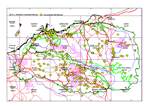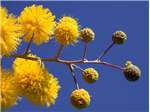Click on images
to enlarge


, with BRM 5759, ORIGINAL SCAN, ADJUSTED_sml.jpg)
Photographer: B.R. Maslin

Photographer: B.R. Maslin

Spiny stipules. Photographer: E. Thoma

Spiny phyllode tip. Photographer: M.W. McDonald

Photographer: E. McCrum
, BRM 8425, ORIGINAL SCAN_sml.jpg)
Photographer: B.R. Maslin

Photographer: E. Thoma

Photographer: B.R. Maslin
, LSWE 7015, lab photo by Fiona McCallum ADJUSTED_sml.jpg)
Seed from one herbarium voucher. Scale in mm. Photographer: F. McCallum.
, habitat, B TCMBC Jun 06 SvL ADJUSTED_sml.jpg)
Spindly variant. Photographer: S. van Leeuwen
, habit 1, BRM 8775 ADJUSTED BY J. FIELD_sml.jpg)
Spindly variant. Photographer: B.R. Maslin
, stem and stipules, F TCMBC Jun 06, Photo SvL, ADJUSTED_sml.jpg)
Spindly variant. Photographer: S. van Leeuwen
, spiny stipules 2, AW TCMBC14 Jun 06 SvL ADJUSTED_sml.jpg)
Spindly variant. Photographer: S. van Leeuwen
, inflorescences2, AD TCMBC14 Jun 06 SvL ADJUSTED_sml.jpg)
Spindly variant. Photographer: S. van Leeuwen
, inflorescences, AU TCMBC14 Jun 06 SvL ADJUSTED_sml.jpg)
Spindly variant. Photographer: S. van Leeuwen
Botanical name
Acacia pyrifolia DC. var. pyrifolia, Prodr. 2: 452 (1825)
Common name
Ranji (preferred common name), Ranji Bush, Kanji Bush, Kanyji Bush or Fire Wattle
Aboriginal name
Ganyji (Ngarluma), Ganyjj or Kanytyi (Yindjibarndi), Ganyji (Banyjima), Kanyji, Jirbarli, Jirparli or Jilparli (Kurrama), Gadarn (Thalanyji), Kartarn (Jiwarli), Munturru (Putijarra) and Munturu or Munturru (Nyangumarta)
Description
Harsh, diffuse, straggly and normally openly branched, glabrous shrubs 1.5-3.5 (-5) m tall with up to 6 main stems from the base, openly branched or sometimes dense and bushy, occasionally single-stemmed (stems normally to about 4 cm diameter at breast height, occasionally 10 cm) and spindly with very sparse foliage. Bark grey at base of main stems on mature plants, smooth, upper branches (and stems of young plants) orange-brown to yellowish or green and commonly pruinose. Branchlets frequently conspicuously pruinose, however, pruinosity can be faint or occasionally absent. Stipules spiny, frequently persistent on old wood where phyllodes have fallen, sometimes absent from some nodes or only the hard bases persisting, normally rigid and rather robust, 3-8 (-10) mm long, straight and wide-spreading. Phyllodes variable, elliptic to oblong-elliptic or orbicular, rarely obovate, (2-) 2.5-6 (-7) cm long, 1.5-4.5 (-6) cm wide, moderately to distinctly coriaceous, often undulate, variably pruinose and ranging in colour from blue-grey (common) to glaucous, sub-glaucous or grey-green, occasionally green; midrib prominent and located along centre-line of phyllode; apex ending in a needle-sharp, spiny tip. Inflorescences prolific and showy, comprising racemes and/or terminal panicles which are much longer than the phyllodes, raceme axes 3-18 cm long and (especially towards their apices) together with the peduncles tinged pale purple when young (not deep purple as in A. inaequilatera) but soon aging yellow-green; peduncles 8-21 (-26) mm long, normally twinned, often with a rudimentary phyllode within their axil; heads showy, globular, about 8 mm in diameter at anthesis when fresh, bright light to mid-golden, densely 70-80-flowered; flower buds yellow or green. Flowers 5-merous; sepals free, linear-spathulate; petals glabrous and nerveless. Pods narrowly oblong, flat but rounded over seeds, 3-9 cm long, 8-15 mm wide, firmly chartaceous, shallowly curved to openly once-coiled, light brown (often tinged greyish) and lightly pruinose; the outer margin shallowly undulate. Seeds transverse to longitudinal in the pods, broadly ellipsoid to ovoid, turgid, 4-6 mm long, dull to slightly shiny, dark brown except pale brown near the very small pleurogram; funicle dull cream, not encircling the seed and scarcely expanded into an aril.
Characteristic features
Harsh, straggly and normally openly branched, glabrous shrubs. Branchlets frequently conspicuously pruinose. Stipules spiny. Phyllodes elliptic to oblong-elliptic or orbicular, rarely obovate, relatively short and broad (mostly 2.5-6 x 1.5-4.5 cm), often undulate, coriaceous, variably pruinose, commonly blue-grey but ranging to glaucous, sub-glaucous or grey-green, occasionally green, midrib prominent and located along centre-line of phyllode; apices spiny. Inflorescences prolific and showy, long racemes (3-18 cm) and/or terminal panicles that exceed the phyllodes, raceme axes and peduncles yellow-green (tinged pale purple when young); heads golden, densely 70-80-flowered. Pods firmly chartaceous, shallowly curved to openly once-coiled. Funicle not encircling seed and scarcely arillate.
Distribution and ecology
Occurs in Western Australia from Carnarvon and near Meekatharra north to Rudall River National Park and Wallal Downs Station, just north of the Pilbara; also in the southern Kimberley region from near Windjana Gorge to near Halls Creek. It is especially common in the Pilbara where it occurs throughout the region, including some of the off-shore islands. Grows principally along watercourses (often with A. bivenosa, A. coriacea subsp. pendens and/or A. trachycarpa) and water-gaining sites where it often forms dense populations which are quite conspicuous in the landscape on account of the often bluish foliage of the plants. Typically favors clay soils with a pebble surface strew. It also favours rocky hill slopes with very stone pediments in some parts of its range, particularly in the vicinity of Whim Creek and in the Gorge Range east of Port Hedland. In some parts of the west Pilbara it is common on sandplains and alluvial flats near the coast. It is also found on rocky outcrops. Variety pyrifolia readily colonises disturbed sites (e.g. road verges) and regenerates well (from seed) following fire. Older plants often support insect galls towards the ends of the branchlets. Seeds have a very strong dominancy mechanism which limits seed germination in fresh seed to only 2% without pre-treatment (Fox and Dunlop 1983).
Flowering and fruiting period
Flowers from late May to October with the main flush in July and August. Pods with mature seeds have been collected in September and October, occasionally November.
Variation
Specimens with non-pruinose branchlets and green, non-pruinose phyllodes are scattered throughout the range of the species (e.g. Burrup Peninsula) and these are sometimes confused with A. pyrifolia var. morrisonii. Some specimens from Barrow and Legendre Islands have rather small phyllodes, 20-30 mm long and 15-20 (-30) mm wide (the normal larger phyllode form also occurs on this island). Also, on some islands in the Dampier Archipelago plants have a very prostrate almost ground-cover habit. An uncommon, single-stemmed, spindly form with very sparse foliage and pruinose stems occurs in the Pilbara and elsewhere, e.g. near Tom Price. In growth form these plants resemble the rare A. aphanoclada x pyrifolia var. pyrifolia putative hybrid that occurs near Nullagine; however, var. pyrifolia is recognized by its less elongate phyllodes (l:w not above 2, whereas in the putative hybrid the phyllode l:w is 4-7).
Taxonomy
Acacia pyrifolia comprises two varieties, var. pyrifolia and var. morrisonii, both of which occur in the Pilbara, but the former is the more common (see var. morrisonii for discussion).
Affinities
The relationship of var. pyrifolia to var. morrisonii is discussed under the latter taxon. Acacia pyrifolia has occasionally been confused with A. inaequilatera (see that species for distinguishing features). These species, together with A. marramamba and A. trudgeniana comprise the informal 'Acacia pyrifolia group'; this group appears related to the 'A. victoriae group'. Acacia pyrifolia appears most closely related to A. strongylophylla from Central Australia.
Notes
As reported by Juluwarlu Aboriginal Corporation (2003) and Young (2007) indigenous peoples of the Pilbara use A. pyrifolia in a variety of ways. The gum (ngarkarla, gardangu or marndala) which is exuded from cracks in the young branches after the plant finishes flowering may act as a mild laxative, but can be eaten straight from the plant or mixed with sugar and water, then left in the sun to set like a toffee. This gum can also be heated in a spinifex fire to become a form of honey. The seeds (thurndu or murnturu) can be eaten, either raw or cooked (roasted seeds have a garlic flavour according to W. Edgecombe, pers. comm.). The green pods (marna) should not be eaten. The bardi grubs (yirranyji) found on this plant are not edible. The inner red bark is pounded and soaked or boiled in water until the liquid becomes thick and red; the solution is then used to bathe sores, cuts and rashes, and is particularly effective in drying open wounds.
As with A. inaequilatera the seeds and immature fruit pods are particularly favoured by galahs and cockatoos.
Conservation status
Not considered rare or endangered.
Origin of name
The botanical name is derived from the Latin pyrum (pear) and folium (leaf) referring to the phyllode shape. In the past there has been considerable confusion between A. pyrifolia and A. inaequilatera concerning the application of their common and aboriginal names. This applies particularly to the common names Ranji, Kanji and Camel Bush which have been variously applied to both species. As a consequence it is likely that the past application of at least some of the aboriginal names which were based on these common names have also been incorrect. We have now standardized the use of Ranji (for A. pyrifolia var. pyrifolia) and Kanji (for A. inaequilatera). Furthermore, the aboriginal names that are here applied to these taxa are based on our judgment and with reference to the citation of the scientific name (we were not guided by the common names used in the literature).
References
Fox, J.E.D. and Dunlop, J.N. (1983). Acacia species of the Hamersley Ranges, Pilbara Region of Western Australia. Mulga Research Centre. Occasional Report No. 3. pp. 94. (Western Australian Institute of Technology: Bentley.)
Juluwarlu Aboriginal Corporation (2003). Wanggalili: Yindjibarndi and Ngarluma Plants. pp. 128. (Juluwarlu Aboriginal Corporation: Roebourne, Western Australia.)
Young, L. (2007). Lola Young: Medicine Woman and Teacher. Complied by Anna Vitenbergs. pp. 160. (Fremantle Arts Centre Press: Fremantle.)
